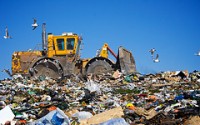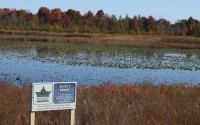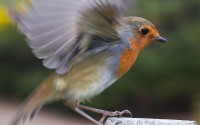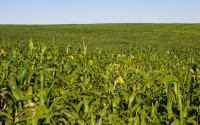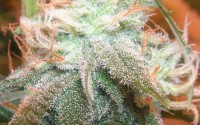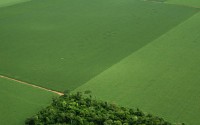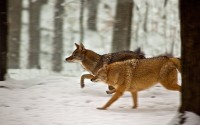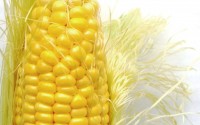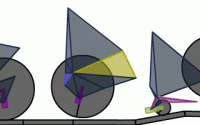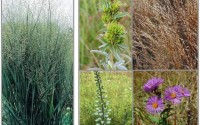Photo Credit: Benson Kua The causes and consequenses of soil temperature in the winter is an important concept to understand. Human management activities in agriculture and conservation can have large impacts on soil temperature. In return, soil temperature has important impacts on the ecology of differnt ecosystem. The causes of soil temperature changes in the winter can easily be studied in the schoolyard. Students will explore the soil and air temperature in different habitats around the schoolyard that may be affected by different ecosystem properties, such as plant, litter or snow cover and human built structures. The patterns in soil temperature are then related to the consequences for the ecosystem around the school and extensions are made to consequences for fields and forests. At the conclusion of this lesson, students will be able to: Take measurements of soil and air […]
Winter Cover Crops
By Nicholas A. Tonelli from Pennsylvania, USA Winter cover crops are planted between harvested crops (Fall – Spring) and provide many benefits to agricultural fields including reduction in nitrate leaching, nitrogen fixation, increased organic matter, weed suppression and others. However, few farmers currently use winter cover crops. The objective of this lesson is to engage middle or high school students in active research that identifies winter cover crop species and phenotypes that would be beneficial for local farmers. Students sow several cover crop species / phenotypes in the fall, measure ground cover in early winter and make plant measurements (biomass, height, root characteristics) in May of the following year. Research results may be reported to local farmers as an educational activity. At the conclusion of this lesson, students will be able to: Engage in constructive agroecology research activities Identify beneficial […]
Thinking About Waste
Waste generation in the U.S. is an enormous problem, as 230 million tons of trash is generated each year. Students must begin to learn about these issues because natural resource depletion and environmental degradation may directly affect their lives in the future. This lesson is designed to get students thinking about how to cut waste in their own lives. They will draw pictures of the Earth in 100 years under two different scenarios. They will also list some ways that the school and families at home can reduce waste, which will be posted in the school hallway. Students should come away from the lesson with a positive outlook, that waste generation can be significantly cut, which will benefit everyone in the world. At the conclusion of this lesson, students will be able to: Understand that an immense amount of waste […]
Volume of Snow and Water
Water and snow do not have the same volume because snowflakes have air pockets trapped inside. When snow melts, the air pockets are released to the atmosphere. In addition, water in the solid form has roughly 9% more volume than in the liquid form because of the way the molecules are bonded together via hydrogen bonds. Therefore, when snow melts, the volume of the water is reduced as air molecules are released and hydrogen bonds are broken. In this activity, students investigate the volume relationship between snow and water, which changes depending on the weather conditions at the time of a snow event and the amount of time since the snow event. Students will use many skills learned regarding making measurements of volume to accomplish this activity, and will understand how much liquid water comes from the snow in one […]
Rainy Day Habitat Lesson
It is important that students learn the different components of habitats and the consequences of removing one or more of those components. This activity can allow empirical study of habitats in the classroom when weather conditions are unfavorable outdoors. This experiment gives earthworms a choice of two habitats and identifies which habitat they prefer. Students will learn that earthworms prefer habitats with high organic matter. Results from this study can then be used to predict where worms prefer to live in the schoolyard or across a landscape. At the conclusion of this lesson, students will be able to: Identify the habitats of familiar organisms and their needs for survival Conduct an experiment to identify preferred habitats of organisms Resources: Lesson Plan Lesson created by Brook Wilke
Microscopic Life in Water
Photo Credit: Frank Fox Examination of water under a microscope uncovers a whole new world that is invisible to the standard human eye. In this activity, students examine the microscopic life in water from multiple sources to find out if there is life in them and if it is different between sources. Students draw pictures of what they see in microscopes and draw conclusions about what they found. Experts suggest that this activity is one of the best at stimulating a child’s interest in exploring the natural world. At the conclusion of this lesson, students will be able to: Identify microscopic organisms that are found in water Differentiate between organisms found in different water sources (lakes, ponds, rivers, drinking, fish tank, etc…) Resources: Lesson Plan Student worksheet Phytoplankton guide Lesson Created by Brook Wilke
Land Conservation Debate
Photo Credit: Southwest Michigan Land Conservancy In 1980, 6% of Michigan’s landscape was covered by urban areas. Experts project that by 2040, 18% of the landscape will be developed into urban areas. This comes at a huge cost to natural landscapes including the ecosystem services they provide. In this activity, students will be divided up into groups that represent different landscapes including farmland, wetlands, forests, prairies and urban areas. Students in these groups will identify reasons and share arguments for protecting natural landscapes or developing areas for urban expansion. Students are allowed to debate the topic between groups and to come up with a reasonable solution to the problem of expanding urban development. Specific examples in the local community provide grounds to really understand how this plays out in the real world. At the conclusion of this lesson, students will […]
Is CO2 An Atmospheric Pollutant?
Photo Credit: Jorge Royan The United States Supreme Court is currently (December, 2006) debating the question, “Is carbon dioxide an atmospheric pollutant?” This lesson provides middle school students with an opportunity to learn about and discuss rising carbon dioxide levels in the atmosphere, which may drastically change their lives in the future. A panel discussion with two-three adults is used to engage students in a discussion about the Supreme Court case. Adults help to share as much information as possible about the issue with students to help them form their own – unbiased opinion on the matter. At the conclusion of this lesson, students will be able to: Define what carbon dioxide (CO2) is State why concentration of CO2 is rising in the atmosphere Understand how CO2 in the atmosphere will cause rapid climate change Understand that rising CO2 increases […]
Iron In Cereal
Many breakfast cereals are fortified with iron, which is essential for transport of oxygen in blood throughout human bodies. The iron is simply sprayed on the cereal and can be separated by physical processes. Students in this lesson use bar magnets to extract iron from crushed up breakfast cereals. Five different cereals are used for the experiment including those with different iron concentrations based on nutritional information. Iron extracted from each cereal type is weighed and compared to the other cereals and the nutritional information on the box. At the conclusion of this lesson, students will be able to: Extract iron from fortified breakfast cereal Conduct an experiment to determine which cereals have the most iron Separate a mixture of cereal and water into magnetic and non-magnetic categories Resources: Lesson Plan Lesson created by Brook Wilke
How Do Birds Fly?
Photo Credit: Paul Tomlin The ability to fly is a fascinating biological phenomenon. In this short activity, students will identify characteristics of birds that allow them to fly, and how these characteristics are different from other animals that cannot fly.Many of these characteristics are listed in this lesson for teacher use, including how bird wings are arc shaped, causing decreased air pressure above the wing compared to below.Students also will learn that not all birds are able to fly. At the conclusion of this lesson, students will be able to: Understand that gravity is a force that pulls objects toward the center of the Earth Understand that not every bird can fly Explain several reasons for why birds are able to fly and many other animals can not fly Resources: Lesson Plan Bird and squirrel picture Lesson created by Brook […]
History and Diversity of American Crops
In this activity, students explore the world of crop history in North America. They begin by choosing a crop species that was historically grown in the Americas, studying the history and ordering bulk amounts of seeds from an heirloom variety that has been around for many years. The students use the bulk seed to run a small- scale seed store where they repackage and sell seed for a profit. Students also examine the characteristics of the seed and use the schoolyard or classroom as a place to plant and examine the growth of the variety they have chosen. Plants may be maintained in the schoolyard or at students homes so that they can save seed to create a seed bank at the school. At the conclusion of this lesson, students will be able to: Provide a detailed history about a […]
Hairy Leaves
Plants have small hairs on their leaves and stems called trichomes.These structures are important for defense from herbivory and protection from cold, heat and drought. Students will investigate leaf hairs of many different plants in the schoolyard using an inquiry based activity.Two hypotheses will be made,one about whether or not all plants have leaf hairs, and whether most plants are highly pubescent (hairy) or modestly pubescent.Leaves will be collected and classified into three categories.Students will create a data table and bar graph from their data and present this to the rest of the class.The teacher will conclude with some ideas about why plants have leaf hairs and try to stimulate future questions from the students about the topic. At the conclusion of this lesson, students will be able to: Conduct a basic scientific investigation to support predictions Explain why plants […]
Habitat Loss and Fragmentation: The Good, Bad, and Ugly
Photo Credit: SUNY JCC Habitat fragmentation is visible all over Michigan. Roads, lawns, buildings, farmland, and other changes in habitat have turned our state, and most others, into a huge patchwork quilt of ecotypes. Unfortunately, the lines between those quilt squares and the small size of those patches has had a huge impact on the wildlife that call Michigan home. Come join us for a session of active games and prizes. You can really see what impacts fragmentation has by putting yourself in the shoes of the critters dealing with the changes we make. Weather permitting we will head outside for some fun, so come dressed for the chill in the air and be prepared to get active and have fun! At the conclusion of this lesson, students will be able to: Explain how habitat fragmentation can influence the survival […]
Food Chain
Students learn about a specific food chain (coyote-squirrel-acorn in this example, but can be any local food chain) in nature and that organisms can be classified as producers, herbivores or carnivores depending on their diet. A game will be played where students take on the role of different organisms in the food chain and act out different cycles.Experimental situations are played out in the game and are designed to help the students understand that there are more organisms lower than higher in the food chain.They will also learn the consequences of separately removing carnivores and plants from the food chain. At the conclusion of this lesson, students will be able to: Understand that energy flows naturally through a locally occurring food chain Define the terms producer, herbivore and carnivore Understand that there must be more individuals at the […]
All About Corn
Photo Credit: Darwin Bell Corn and soybeans cover 6% of the total land area in the United States and are grown on 15 times as much land as all fruits and vegetables combined.In this activity, students will take a walk out into a corn field to become more acquainted with this crop that is so common.Students will make calculations for the number of plants and ears of corn per acre and then estimate the total number of ears grown in the U.S.in 2002 based on USDA data.Students will be informed about the different types of corn available and that most of it is actually used for products other than human food. Finally, corn is a crop that requires high amounts of energy and nutrients to grow successfully, making it a crop that can potentially contribute to environmental pollution if managed […]
Where does plant mass come from?
Photo Credit: Audrey from Central Pennsylvania, USA Tracing matter in the gaseous form is difficult to teach and requires carefully planned activities. Plant growth is one way to teach students that most of the mass of the plant comes from somewhere other than the soil, but mostly in carbon dioxide and hydrogen atoms from water. To identify this, students will be planting seeds indoors, weighing the dry pot, soil and seed first and then the dry pot, soil and plant later. The total mass of the soil and pot will be nearly equal before and after the experiment. Students will also measure plant height throughout the experiment. Students will be able use the data from the experiment to make graphs and conclusions, which are important concepts for upper elementary students. After discovering that most of the plant mass does not […]
2013 Summer Institute Recap
It was the last week of June and KBS was a hive of activity. The annual K-12 Summer Institute lasted just 3 days this year but was action packed. Sessions were conducted by the GK-12 fellows, both new and returning, and by the MSP research associates. Since the institute ran for just three days, we had a plenary session everyday! Our first plenary speaker was Dr. Carolyn Malmstrom from the Dept. of Plant Biology at MSU. She spoke on the topic ‘It’s a small small world: Plant viruses and ecology’. She was a perfect fit for us since one of the questions she focuses on is ‘How do we preserve biodiversity and ecosystem services in working landscapes’? Sounds a bit familiar, right? Dr. Malmstrom started her talk by describing viruses as a ‘space capsule with a protein coat containing genomic […]
Science Education beyond GK-12
Former GK-12 fellow Kali Bird continues to train teachers and bring exciting science to K-12 classrooms as an Education Program Specialist with the Cary Institute of Ecosystem Studies in Millbrook, New York. During the 2010-2011 academic year, she partnered with Sandy Breightenbach of Plainwell High School, gaining experience and improving her ability to communicate science, while invigorating the classroom with inquiry-based lessons based on the latest scientific research. She says that “the experience of working with kids and teachers through the GK-12 program helped me to better understand the interests and needs of both; while the practice of presenting the process and insights of science to varied audiences improved my ability to communicate these effectively, meaningfully, and confidently.” Since January, she has been developing and updating data-driven curriculum focused on the Hudson River and its watershed. Leaders of the Cary […]
K-12 Partnership Summer Institute–this week!
This upcoming June 24-26 (Mon.-Weds.), KBS will again host the K-12 Partnership Summer Institute! We have a superb group of Partner-Teachers hailing from 11 of our SW Michigan partner districts, 5 brand new Fellows, and 4 returning Fellows. All have been hard at work, both developing new, exciting lessons to introduce at the institute and learning about each others’ roles as scientists and educators. This year, the institue features three invited plenary speakers from Michigan State University: Drs. Carolyn Malmstrom, Catherine Lindell, and Maren Friesen, as well as a special seminar session on the Next Generation Science Standards with Nancy Karre (BCAMSC), Cheryl Hach (KAMSC), and Sara Syswerda (MSU, KBS). The full schedule, including abstracts of all concurrent sessions, can be found here. If you plan to attend (and we hope you will!) please RSVP to Sara S. at parrsar1@msu.edu .
Fellows Liz Schultheis and Nick Ballew receive awards
Congratulations to former GK-12 Fellows Liz Schultheis and Nick Ballew for the following awards granted this spring: Liz received the 2012-2013 Fields Teaching Award from the MSU Department of Plant Biology. The award is given once annually to a Plant Biology graduate student, “recognizing originality in teaching methods and a recipient’s ability to generate enthusiasm about learning and to influence student attitudes and interests”. Liz has honed her teaching and science communication skills over the last three years of service as a GK-12 Fellow. She is also beginning a second year of partnering with the BEACON Center for the Study of Evolution in Action. She has created and presented many lesson plans for K-12 students, hosted workshops for K-12 teachers, and attended local and national education conferences (GK-12 annual meeting, MSTA, NABT, ESA Life Discovery). She helped co-create Data Nuggets and is […]
Project GREEEN call for proposals!
The above Call for Proposals is sponsored by Project GREEEN. Originally known as the Plant Initiative, Project GREEEN is a collaborative effort by plant-based commodities and businesses in cooperation with AgBioResearch (formerly the Michigan Agricultural Experiment Station), MSU Extension, and the Michigan Department of Agriculture and Rural Development (MDARD) to advance Michigan’s economy through its plant-based agriculture. Its mission is to develop research and educational programs, ensure and improve food safety and protect and preserve the quality of the environment. If you are curious where you can find Michigan native plants for your backyard or schoolyard, see: Michigan Retail Sources of Native plants (.docx)
GK-12 Fellow showcases BoxCar2D at the MSU Science Festival
The inaugural MSU Science Festival kicked off this weekend in East Lansing and Fellow Anne Royer was featured as a presenter in this State News article. Anne ran a hands-on demonstration of “Darwin Builds Better Cars” all day Saturday and Sunday, in the Biomedical and Physical Sciences building on campus. Participants learned about evolutionary processes by first building Lego cars and testing their models on short tracks, then used online software (BoxCar2D) to optimize 2D car design on various types of terrain. Fellows Anne, Liz Schultheis, and Sara Garnett recently presented “Darwin Builds Better Cars” at the K-12 Partnership Workshop in March.
BeSt Plot Data: Student-Guided Inquiry in Lawton Classrooms
After days of work in the field and lab collecting data on their BeSt biofuel plots, four classes at Lawton Community Schools – Ms. Angle’s 8th-graders and Ms. Visich’s Environmental Science class – finally got to enjoy the fruits of their labor. As any scientist knows, no fruit is more satisfying than juicy, crunchable data. We started this adventure by looking at what kinds of data we had. This included the planting, fertilization, and harvesting treatments as well as the data we collected, from plant and insect biodiversity to soil characteristics. Each student made his or her own hypothesis about why a pair of variables might be related. Does fertilization increase insect abundance? Does moisture increase plant biomass production? Only one way to find out… The students plotted their data by hand, then ventured into the computer lab to produce […]
Big Roots for Big Problems: Exploring the Ecosystem Services of Roots
Student will explore the idea of what ecosystem services are, focusing on the importance of plant’s root systems. A brief introduction to ecosystem services will be followed by an interactive demonstration illustrating a basic ecosystem service. Then students will have an opportunity to construct their own root systems and test out their designs to see how they fare in a heavy rain event. Finally, after conducting a month long experiment with different watering regimes, students will determine whether certain plants are more equipped to deal with drought and what makes them better. This is a highly interactive lesson that requires some preparation prior to implementation. Objectives At the conclusion of the lesson, students will be able to: Understand how healthy ecosystems provide valuable services Distinguish between four different categories of ecosystem services Understand the specific role of roots in providing […]
Fellows present at Plant Science Symposium
GK-12 fellows Tyler Bassett and Jake Nalley have been honing their public presentation skills all year in middle and high school classrooms. On March 29, they put those skills to good use by participating in the Plant Science Graduate Student Research Symposium that was hosted on Michigan State’s East Lansing campus. Both presented on their individual research topics in front of a small crowd and judges. Tyler and Jake both research the many benefits that can come from diversity, a topic that should be familiar to students and teachers that have studied the BEST Plots. Tyler focused on how diversity may be a crucial factor in resisting invasive species in restored prairies. Jake spoke about how growing multiple species of algae together results in higher levels of biomass that can be converted into biodiesel fuel. Tyler received third place in the […]
BoxCar2D ~ Evolving better cars: teaching evolution by natural selection through inquiry
In this lesson, students explore how the basic principles of evolution can be used to produce a better vehicle using web-based software. The program, BoxCar2D, allows the user to observe evolution in action with cars in a virtual environment and design vehicles to move over a variety of 2- dimensional landscapes. The program utilizes the basic principles of biological evolution: mutation, reproduction with recombination, and selection (moving faster and farther = higher fitness). Objectives Through guided exploration of the dynamics of digital evolution in BoxCar2D, students will gain an understanding of the following concepts: Evolution happens over generations in populations, not to an individual within its lifetime. Mutations and recombination create variation. Although much of the variation is not helpful, some of it is – this random variation allows evolution by natural selection to solve problems in novel and efficient […]
BEST Plots ~ Using student-collected data in the classroom
In the following lessons, we use questions generated for and data collected from the BEST (BioEnergy SusTainability) plots to have students make predictions, draw graphs, interpret data patterns, and support claims with evidence. Students play a fun and engaging game that helps them think about the biology involved in how plants grow or how invertebrates find food in their environment. The outcomes of the game help students make predictions. We also have four classroom activities, based on the Data Nugget model, that get students looking at real data, making graphs, and answering questions by making evidence based claims. These lessons focus on parts of the overarching scientific question for the BEST plots: “Can we grow our fuel and save our flowers and butterflies, too?” These lesson plans address the following questions: How do the kinds of plants we planted (switchgrass […]
Water in the Classroom: Lake Mixing
Ever wonder why when you dive in a lake, there is a sudden drop in temperature? Russ Stolberg’s 8th grade Earth Science students have been discussing why we observe this phenomenon in our lakes and oceans. It all has to do with density! Cold water has a higher density than warmer water, and as solar radiation continually warms the surface of our lakes it makes this separation even more pronounced. I [Jake] had the pleasure working with the students on an exciting lab simulating how waters can become layered, or stratified, and then simulate how this stratification can be broken down through natural processes. Groups of students each got to work with their own pond (a clear plastic tub), which was heated by the sun (a heat lamp) and received warm wind via a blow dryer. We started with “Winter” […]
GK-12 presents at MSTA
On March 8th, Dave Williams (GK-12 partner teacher and RET) and Liz Schultheis (GK-12 fellow) presented at the Michigan Science Teachers Association Conference (MSTA). Dave developed this lesson while working as an RET in Jen Lau’s lab, where graduate student Liz studies the role of enemies in plant invasions. The lesson covers invasive species in Michigan (like purple loosestrife and garlic mustard), and guides students through collecting data to test the Enemy Release Hypothesis – which posits that invasive species escape from natural enemies in their invasive range, contributing to their success. In this lesson, students develop predictions, design experimental sampling methods, collect data, and create graphs for data interpretation. Participants were also introduced to Data Nuggets – activities where students can practice making claims based on scientific data. Lesson and other materials available via these links: Presentation Slides […]
Register now for a FREE summer workshop for high school biology teachers!
Whether you’re new to inquiry learning in your classroom, or you’re looking for new projects to spice up your curriculum, this workshop is for you! Come enjoy an intensive week of field and lab exploration, working with scientists and educators. Participants will experience five days of cutting edge research, while creating lessons that will work in the classroom and with the Next Generation Science Standards. Lessons cover a diverse set of topics, including ecological field research, mathematical modeling, evolution, and computer simulations. Not only will participants come away with new research ideas, but more importantly, an increased comfort with the process of real science – including the unexpected and exciting new results that come from scientific inquiry! Room and board at Kellogg Biological Station paid by the BEACON Center for the Study of Evolution in Action at Michigan State University. […]
Garnett Jeopardy!
State News Article (in case the above link doesn’t work)



